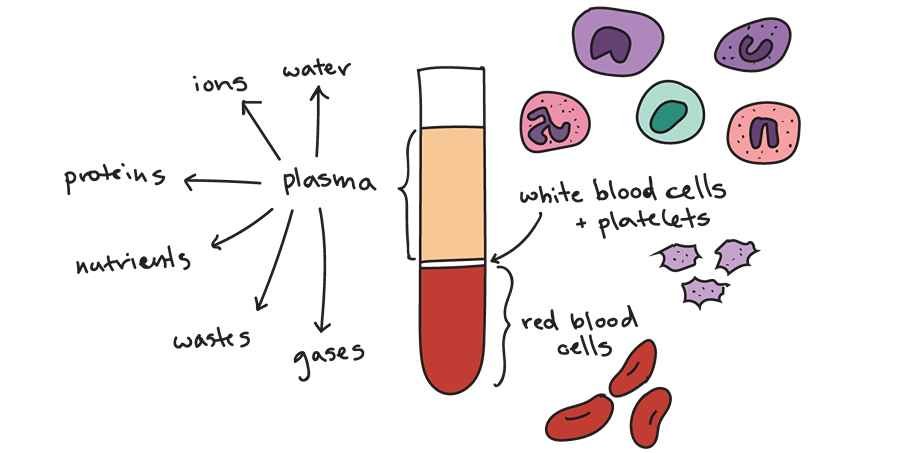A blood transfusion is a life-saving medical procedure in which blood or blood products are transferred from one person (the donor) into the bloodstream of another person (the recipient).
It is commonly used to replace blood lost during surgery or trauma, to treat certain medical conditions, or to improve the patient’s overall health.
They play a crucial role in modern medicine, treating a wide range of conditions and saving countless lives every year.
The human blood
Blood is a complex liquid tissue that performs several vital functions in our body.
It carries oxygen and nutrients to our cells, removes waste products, and plays a crucial role in our immune system.
However, blood loss due to accidents, surgeries, certain diseases, or internal bleeding can be life-threatening.
Why are blood transfusions needed?
There are several reasons why someone might require a blood transfusion:
- Blood loss: Accidents, surgeries, and certain medical conditions can lead to significant blood loss. Transfusions replenish red blood cells, which carry oxygen throughout the body, and plasma, the liquid portion of blood that transports nutrients and proteins.
- Cancer treatment: chemotherapy and radiation therapy can damage bone marrow, hindering red blood cell production. Transfusions help maintain healthy blood cell levels during cancer treatment.
- Blood disorders: individuals with these disorders, such as sickle cell disease or thalassemia, can require transfusion when they fall ill and have low red cells in their blood, as evidenced by low packed cell volume.
- Bleeding disorders: Individuals with hemophilia, thrombocytopenia, or other bleeding disorders may require transfusions to replace clotting factors missing in their blood.
- Surgical procedures requiring significant blood loss can involve blood transfusion
- Trauma or injury resulting in significant blood loss
Types of Blood Transfusions

Blood isn’t a single substance; it’s a complex mixture of components.
Depending on the patient’s needs, different blood components can be transfused.
- Whole blood: this is the least common type and is typically only used in severe cases of blood loss where all blood components are needed.
- Red blood cells (RBCs): the most common transfusion type, RBCs are essential for oxygen transport. They are separated from whole blood and transfused to treat anemia and blood loss.
- Plasma: the liquid portion of blood containing proteins, clotting factors, and electrolytes. Plasma transfusions are used to treat deficiencies in specific clotting factors or to replace lost plasma volume.
- Platelets: tiny cell fragments crucial for blood clotting. Platelet transfusions are used to treat or prevent bleeding in patients with low platelet counts.
How a blood transfusion is done
1. Patient assessment
Before initiating the blood transfusion, assess the patient’s medical history, vital signs, and current condition to determine the need for transfusion and identify any potential risks or contraindications.
Obtain informed consent from the patient or their legal representative, explaining the purpose, risks, and benefits of the transfusion.
2. Blood compatibility
Check the patient’s blood type (A, B, AB, or O) and Rh factor (positive or negative) through blood typing and crossmatching.
Verify the compatibility of the donor’s blood with the recipient’s blood type to prevent transfusion reactions.
3. Blood products
Based on the patient’s clinical condition and transfusion requirements, select the appropriate blood products, such as packed red blood cells, platelets, fresh frozen plasma, or cryoprecipitate.
Ensure proper storage and handling of blood products according to established guidelines to maintain their integrity and safety.
4. Pre-transfusion procedures
Wash hands thoroughly and don gloves to maintain the aseptic technique.
Identify the patient using two unique identifiers (e.g., name and date of birth) and compare them with the blood product label to ensure proper patient identification.
Inspect the blood product label for accuracy, including blood type, expiration date, and donor information.
Check the blood product for signs of hemolysis, contamination, or visual abnormalities.
5. Transfusion process
Prime the blood administration set with normal saline or an appropriate intravenous solution to remove air and ensure a continuous flow of blood.
Use a blood warmer if indicated to prevent hypothermia during transfusion.
Start the transfusion at a slow rate (e.g., 2-4 mL/minute) for the first 15 minutes while closely monitoring the patient for signs of adverse reactions.
Gradually increase the transfusion rate to the prescribed rate (typically 1-2 units per hour for packed red blood cells) as tolerated by the patient.
6. Patient monitoring
Continuously monitor the patient’s vital signs, including temperature, heart rate, blood pressure, and oxygen saturation, throughout the transfusion process.
Observe the patient for signs of transfusion reactions, such as fever, chills, rash, dyspnea, hypotension, or back pain.
Stop the transfusion immediately if any adverse reactions occur, and initiate appropriate interventions as needed.
7. Post-transfusion assessment
After completing the transfusion, assess the patient for any immediate adverse effects or complications.
Document the transfusion procedure, including the type and volume of blood products transfused, the patient’s response, vital signs, and any adverse reactions.
Dispose of blood administration equipment and blood product containers according to biohazard waste disposal protocols.
8. Follow-up care
Provide ongoing monitoring and supportive care to the patient as needed following the transfusion.
Evaluate the patient’s response to the transfusion, including improvements in symptoms, hemoglobin levels, and overall clinical status.
Follow institutional guidelines for documenting and reporting transfusion-related adverse events.
9. Patient education
Educate the patient and their caregivers about the signs and symptoms of transfusion reactions and when to seek medical attention.
Discuss any potential long-term implications of recurrent transfusions, such as iron overload or alloimmunization.
Provide written instructions and contact information for follow-up care or concerns related to the transfusion.
Safety measures in blood transfusion
Rigorous safety protocols are followed to ensure the safety of blood transfusions
- Donor screening: Potential blood donors undergo extensive screening for transmissible diseases like HIV, hepatitis, and syphilis.
- Blood typing and matching: Donors and recipients are carefully matched based on blood type compatibility (ABO and Rh systems) to prevent adverse reactions.
- Blood testing: Donated blood undergoes rigorous testing for infectious diseases and other potential risks.
- Leukocyte reduction: In some cases, white blood cells are removed from donated blood to minimize the risk of febrile reactions (fever and chills) in the recipient.
Risks and complications
While blood transfusions are generally safe, they carry certain risks and potential complications, including:
- Transfusion reactions: These may occur if the recipient’s immune system reacts to the transfused blood, leading to symptoms such as fever, chills, rash, or shortness of breath. Severe reactions, such as hemolytic transfusion reactions, can be life-threatening.
- Transmission of infections: Although blood is screened for infectious agents, there is still a small risk of transmitting infections, such as HIV, hepatitis B and C, or bacterial infections.
- Transfusion-related acute lung injury (TRALI): a rare but serious complication affecting the lungs.
- Fluid overload: Rapid or excessive transfusion of blood or blood products can lead to fluid overload, resulting in symptoms such as shortness of breath, hypertension, or heart failure.
- Iron overload: Regular blood transfusions may lead to iron overload in the recipient’s body, potentially causing organ damage over time.
Conclusion
Blood transfusion is a vital medical intervention that has saved countless lives worldwide.
However, it is essential to carefully weigh the risks and benefits of transfusion and ensure proper screening and monitoring to minimize complications.
Healthcare providers play a crucial role in ensuring blood transfusions’ safe and effective administration to patients in need.
Obisesan Damola
Damola is a medical doctor who has worked in the Nigerian healthcare industry for a little over 3 years in a number of primary, secondary, and tertiary hospitals. He is interested in and writes about how technology is helping to shape the healthcare industry. He graduated from the College of Medicine, University of Ibadan, the foremost medical training institution in Nigeria.



